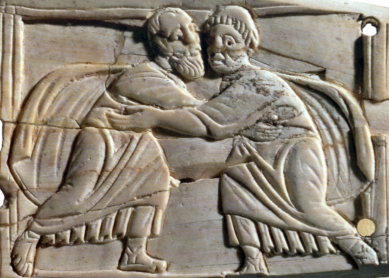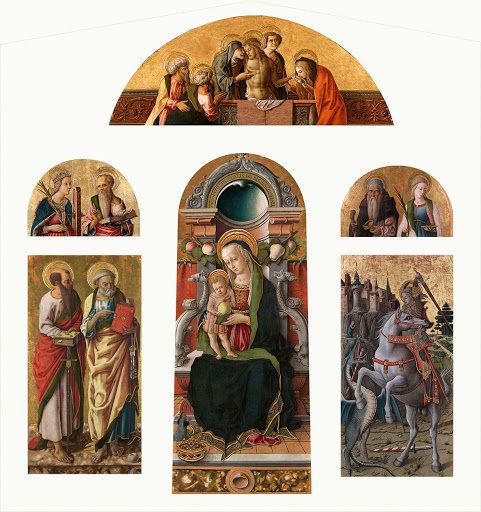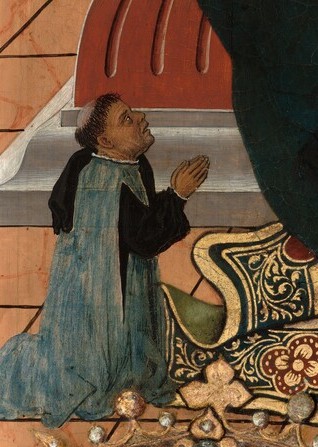
“Saints Peter and Paul”, Carlo Crivelli, c.1470, National Gallery London. Saint Peter is on the right with his keys and Saint Paul is on the left with a sword. As was the established practice, Saint Peter is shown as older than Saint Paul, with white hair, a tonsure and and a beard. Saint Paul is shown with dark brown hair and a long beard. As in the gospels, both wear a tunic next to the skin with an outer garment over it. Their skin is that of fishermen; darkened by the sun and the wind. Their bare feet signify their following of Christ in the way of humble discipleship. In showing the two saints together in the same image, Crivelli may be drawing on the motif known as the concordia apostolorum, in which the two apostles embrace. There is a tradition that they met and embraced as they were led to their respective martyrdoms, but the motif of their embrace has several layers of meaning and it is found widely in early Christian art. One early example is an ivory belt buckle dating from the fifth century which was found at Castellammare di Stabia near Naples (see below).

However, Crivelli does not show them embracing. Rather, he shows a teaching moment.
In his left hand Saint Peter holds an open book, which was a sign of true doctrine. With his right hand, he points out a passage to Saint Paul. Both saints seem to be reading it intently. The Book in Saint Paul’s right hand is closed, but one page is marked. Crivelli used layers of gesso to give emphasis to the brass furnishing of these two books. Along with the haloes, the keys and the sword they stand out from the flat surface. Saint Peter is presented as the one who is instructing Saint Paul in important doctrine.
As you would expect this panel was not free-standing but was part of a polyptych. You can see it below on the right in an image of the reconstructed altarpiece.

It was made for the parish church of Porto San Giorgio which served as the port for the city of Fermo on the east coast of Italy. It worth remembering that Fermo was within the Papal States. The big controversy of the day had been whether ultimate authority in the Church rested with the Pope or with a General Council. It is fairly obvious that here Saint Peter is exercising that authority which he received from Christ and passed on to his successors as the Bishop of Rome.
One odd thing about this image is that Saint Peter is on the right and Saint Paul is on the left. Usually it is the other way around. (But not on the belt buckle above) But, of course, when you look at the whole polyptych, Saint t Peter is in fact to the left of the Virgin and Child, or significantly, at their right hands. This positioning of Saints Peter and Paul on the left and the right respectively gives priority to Saint Peter. Clearly, Crivelli needed to show the two Apostles together in the same panel and so he gives priority to Saint Peter in this rather idiosyncratic way so that he can have both saints on the right! There is a later panel in the National Gallery in London in which he shows Saint Peter dressed in the full regalia of a Medieval Pope.

But there is a further significance to their positioning on the left and the right. Saints Peter and Paul are often referred to as the pillars of the Church. There may be a reference in this to the two pillars at the entrance to the Temple of Solomon. “He set up the pillars at the vestibule of the Temple; he set up the pillar on the south and called its name Jachin; and he set up the pillar on the north and called its name Boaz” (1 Kings 7:21). Now the temple faced east and so Jachin is on your right as you entered and Boaz on your left. Although the meaning of these names is not certain, Jachin is commonly held to mean “he will establish with strength” and Boaz is the name of the Israelite who married married Ruth. In this reading, Saint Peter is the rock upon whom Christ founds his Church and Saint Paul is the one who gathers the Gentiles into the Church.
Porto San Giorgio was situated on the Adriatic and was a point of entry for Albanian immigrants. Initially, they came fleeing the plague but after the fall of Constantinople in 1453 they were fleeing the Turks. Some were rich. One tradition is that this altarpiece was commissioned by one of these immigrants who was a rich merchant by the name of Giorgio da Prenta Albanese. After the church was demolished in1803 the descendants of Giorgio da Prenta took possession of it. In 1835 they sold individual panels for a total of 90 scudi. However, there was a claim made against the purchaser by the Commune of Porto San Giorgio and the purchaser had to pay the Commune the much larger sum of 300 scudi. Obviously, both parties had some claim.
The central panel of the Virgin and child actually shows a donor. It is the tiny figure at her feet on the left. Is this Giorgio da Prenta? With his tonsure, his blacked hooded gown and grey cloak, he looks like a priest but analysis has shown that this figure is a later addition.

Nobody knows if Giorgio was the original patron or if his descendants had acquired the patronage later on. The panel on the far side of the Virgin and Child shows his own patron saint, Saint George, who is slaying the dragon. This is hardly surprising, given the fact that he is also patron of the port. Moreover, to ask the protection and intercession of a warrior-saint would seem reasonable given the threat of Turkish invasion from the sea. The polyptych then is like and assembly of prayers to the Virgin and Child, asking the intercession of Saints Peter and Paul, who handed on the true faith, and also of Saint George for protection against the pagan enemy without. These prayers would surely be close to the heart of the Albanian merchant and to the city where he had made a new home for his family.
The Catholic Chaplaincy serves the students and staff of the University of Edinburgh, Edinburgh Napier University and Queen Margaret University.
The Catholic Chaplaincy is also a parish of the Archdiocese of St Andrews and Edinburgh (the Parish of St Albert the Great) and all Catholic students and staff are automatically members of this parish.